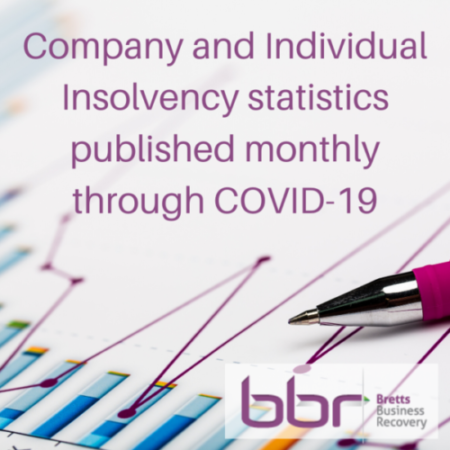Company and Individual Insolvency statistics published monthly through COVID-19

Throughout the remainder of the coronavirus (COVID-19) pandemic and for the immediate future, the Insolvency Service has committed to releasing monthly company and individual insolvency statistics for England and Wales, and monthly company statistics for Scotland.
The change from quarterly to monthly updates offers ‘provisional experimental statistics to provide faster indicators of the impact of the pandemic’.
Early indications
Total numbers of company and individual insolvencies fell immediately after the UK lockdown was applied on 23 March and have not returned to pre-lockdown levels.
Contributing factors include:
- HM Courts & Tribunals Service reducing courts and tribunals operations
- HMRC reduction in enforcement activity
- The Insolvency Service, insolvency practitioners and Companies House having to adjust to new working arrangements
- Delays in documents being provided to Companies House by insolvency practitioners
Statistics update for May 2020
Whilst it’s still a little early to determine any significant trends, figures for May 2020 (released on 12 June) show the number of company insolvencies remained low, driven by a reduction in compulsory liquidations.
In summary:
- The average daily numbers of compulsory liquidations fell to just 20% of the pre-lockdown March figures and a fall of 88%, when compared to the May of the previous year.
- The numbers of individuals entering insolvency through debt relief orders or bankruptcies remained low in May, when compared to pre-lockdown levels. The fall in DROs and debtor bankruptcies corresponds with a reduction in applications for these services which coincided with the announcement of enhanced Government financial support for individuals and businesses.
- The numbers of individual voluntary arrangements returned to pre-March levels in April and increased in May. (However, the Insolvency Service has pointed out that IVAs were elevated in May because of technical issues resulting in delayed registration).
The numbers in detail – May 2020*
Company insolvencies
In May 2020 there were a total of 944 company insolvencies in England and Wales, comprised of 790 creditors’ voluntary liquidations (CVLs) 32 compulsory liquidations, 110 administrations and 12 company voluntary arrangements (CVAs).
There were no receiverships.
Overall, this was a decrease of 30% when compared to the same month last year. This was driven by a decrease in the number of compulsory liquidations in May 2020, which fell by 88%, when compared to May 2019.
This reduction may be explained by the fact that compulsory liquidations require a winding-up order to be obtained from the court by a creditor, shareholder or director. Since the UK lockdown was applied on the evening of 23 March, the HM Courts & Tribunals Service has reduced the operational running of the courts and tribunals.
The Government also announced in late April that it would prohibit the use of statutory demands and certain winding-up petitions from 27 April to 30 June 2020.
CVLs
There was also a 17% decrease in the numbers of CVLs in May 2020 compared to May 2019, and a 61% decrease in CVAs.
Administrations rose by 16% compared to May 2019, but this was driven by lower numbers of Administrations in May 2019, rather than much higher numbers in the most recent month.
Short-term effects of lockdown
During the first three weeks of March, prior to the UK lockdown on the 23 March, an average of 66 company insolvencies were registered daily.
In the remaining six working days following lockdown in March, the average daily number of company insolvencies registered had more than halved to 29.
This reduction is linked to:
- Short-term capacity constraints at Companies House as it put in place safe processes to manage its work on-site; and
- Delays in documents being provided to Companies House by insolvency practitioners.
Throughout April and May the average daily numbers of registered company insolvencies had increased but remained lower than pre-lockdown levels. This was particularly the case for compulsory liquidations which fell 80% from an average of ten new cases per day in pre-lockdown March, to an average of two cases per day in May.
Debt relief orders and bankruptcies
There was a 32% reduction in DROs registered, compared with May 2019 and bankruptcies fell 49% in comparison to the same month as last year.
There were 1,540 debt relief orders (DROs) and 739 bankruptcies in May 2020 in England and Wales (the latter was made up of 690 debtor bankruptcies and 49 creditor bankruptcies).
The reduction in bankruptcies was driven by a 40% fall in debtor bankruptcies and an 83% reduction in creditor bankruptcies. The fall in DROs and debtor bankruptcies corresponds with a reduction in applications for these services, which coincided with the announcement of enhanced Government financial support for individuals and businesses since the emergence of the coronavirus pandemic.
The fall in creditor bankruptcies will likely have been a result of reduced HMRC enforcement activity during this period and in part, a result of reduced operational running of the courts.
IVAs
There were 7,899 IVAs registered, on average, each month during the three months ending May 2020. This was an 11% increase when compared with the average number of registered IVAs during each of the three months ending May 2019.
*These figures are taken from the Insolvency Service Statistics for May 2020 – see the full report here – link